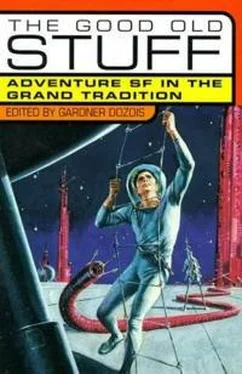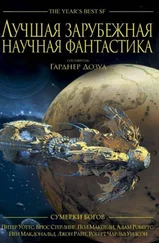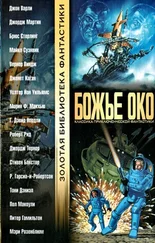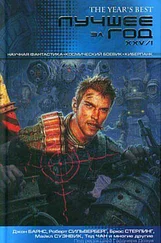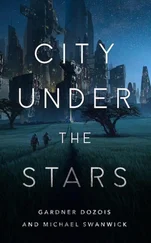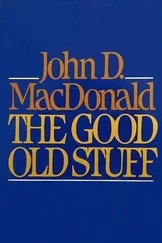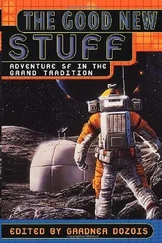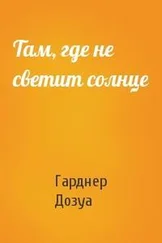Гарднер Дозуа - The Good Old Stuff
Здесь есть возможность читать онлайн «Гарднер Дозуа - The Good Old Stuff» весь текст электронной книги совершенно бесплатно (целиком полную версию без сокращений). В некоторых случаях можно слушать аудио, скачать через торрент в формате fb2 и присутствует краткое содержание. Год выпуска: 1998, ISBN: 1998, Издательство: St. Martin's Griffin, Жанр: Фантастика и фэнтези, на английском языке. Описание произведения, (предисловие) а так же отзывы посетителей доступны на портале библиотеки ЛибКат.
- Название:The Good Old Stuff
- Автор:
- Издательство:St. Martin's Griffin
- Жанр:
- Год:1998
- ISBN:0-312-19275-4
- Рейтинг книги:3 / 5. Голосов: 1
-
Избранное:Добавить в избранное
- Отзывы:
-
Ваша оценка:
- 60
- 1
- 2
- 3
- 4
- 5
The Good Old Stuff: краткое содержание, описание и аннотация
Предлагаем к чтению аннотацию, описание, краткое содержание или предисловие (зависит от того, что написал сам автор книги «The Good Old Stuff»). Если вы не нашли необходимую информацию о книге — напишите в комментариях, мы постараемся отыскать её.
The Good Old Stuff — читать онлайн бесплатно полную книгу (весь текст) целиком
Ниже представлен текст книги, разбитый по страницам. Система сохранения места последней прочитанной страницы, позволяет с удобством читать онлайн бесплатно книгу «The Good Old Stuff», без необходимости каждый раз заново искать на чём Вы остановились. Поставьте закладку, и сможете в любой момент перейти на страницу, на которой закончили чтение.
Интервал:
Закладка:
The very term “Space Opera”—coined in 1941 by Wilson Tucker (on the model of the older, and also negative, terms “Soap Opera” and “Horse Opera”) to describe the “hacky, grinding, stinking, outworn, spaceship yarn”—has a derisive edge to it, a disapproving edge that has stuck with the term ever since. Even today, Space Opera has a raffish, slightly disreputable, Not Quite Nice, disapproved-of outlaw tang to it—so that people who like Space Opera are often just the faintest bit hang-dog or shamefaced about admit-ring it, as if they’ve been caught in a Guilty Pleasure, something we like even though we know it’s Bad for us, and probably not Politically Correct, like admitting to binging on potato chips or Chocolate Chip Cookie Dough ice cream, or being caught out ordering a junk-food hamburger for dinner instead of a healthy Chef’s salad, or watching Gunsmoke reruns instead of Masterpiece Theater. (Ironically, it may be this very whiff of Beyond-The-Pale that has attracted new writers, seeking for a chance to run up the pirate flag and be Outlaws, to the form in the ‘80s and the ‘90s.) The effect of the Campbellian revolution was exacerbated in the beginning of the decade of the ‘50s by the founding of two new major SF magazines, Galaxy and The Magazine of Fantasy & Science Fiction , whose editors would push the accepted model for the science fiction story even further in the direction of psychological and sociological maturity and literary sophistication of style and conceptualization, sometimes further than Campbell himself was willing to go—and would also therefore push it even further away from the familiar pulp adventure tale, which as a result became even more declasse.
Another ironic effect of all this, the Campbellian revolution followed by the launching of Galaxy and F&SF was that literary standards went up throughout the field, even at magazines such as Planet Stories and Thrilling Wonder Stories and Startling Stories , whose readers now also wanted to get a product that was better written line-by-line. so that even in the pulp adventure market, a clumsy and poorly written story that would have been accepted without question in 1935 might have more difficulty getting into print in 1955—and the level of craft needed to get an adventure story into one of the mainline magazines such as Astounding or Galaxy or F&SF rose sharply. The literary ante had been upped, permanently, for the entire genre, low-end as well as high-end.
(And some of the stuff those “low-end” markets would publish as the SF adventure story struggled to evolve, work by Jack Vance, Ray Bradbury, Charles Harness, Theodore Sturgeon, and others, although not widely accepted at the time, would in retrospect look just as good if not better than much of the more “respectable” fare offered by the mainline magazines.) This helped me set one parameter for the book. I didn’t want a book comprised of dusty museum pieces, literary curiosities so out-of-date in terms of style and aesthetics that they could only be enjoyed through a lens of nostalgia; I wanted a book that contemporary readers could enjoy, stories that would be as vivid and entertaining to today’s readers as anything else they can find on the bookstore shelves—and that meant that a certain median level of line-by-line craft was essential. The blunt truth is, many of the classic stories of the ‘20s and ‘30s, although they contain the seeds of much later work within them, are so poorly written line-by-line (and so dated stylistically even when they aren’t clumsy) that they are opaque and impenetrable to many modern readers. So I decided that I would omit coverage here of the “Super-science” era of the ‘30s (already heavily covered anyway in anthologies such as Isaac Asimov’s Before the Golden Age and Damon Knight’s Science Fiction of the Thirties ), and concentrate on work published after World War II instead, a period of swift change and forced evolution in the magazine market, when many of the aesthetic lessons of the Campbellian revolution had already been absorbed and applied. Besides, “after World War II” made a neat and symbolically obvious starting point—the science fiction scenes before the war and after the war were radically different, and even some of the authors who had been publishing prewar, such as Jack Williamson and Clifford D. Simak , would change their styles and approaches radically after the war.
Deciding to start after World War II set one limiting parameter, but that still left almost fifty years to cover until the present day, too much territory to cover adequately in one volume. The book would have to be broken into two volumes, and was, with the upcoming volume to be called The Good New Stuff . But the question still remained: where to break it?
The SF adventure story, and particularly those specialized forms known as the Space Adventure and Space Opera, underwent hothouse forced evolution in the ‘50s and in the early and mid-’60s. In retrospect this time might be seen as the second great Age of the Space Opera, although that fact is often obscured by the attention paid—both then and now—to the work being done outside the compress of the Space Adventure, especially by the Galaxy writers. And yet, during those years, writers such as Poul Anderson and Jack Vance and James H. Schmitz were at their most prolific, L. Sprague de Camp was publishing his tales of the Viagens Interplanetarias, Cordwainer Smith was producing the best of his Instrumentality stories, Brian W. Aldiss was helping to invent the modern science-fantasy form with the outrageous and gorgeously colored adventures (loudly attacked at the time for not being scientifically plausible—as indeed they were not, although to protest that is almost to miss the point) of his “Hothouse” series, Robert A. Heinlein was (with mixed success) diluting the Space Adventure story to make it acceptable to the readers of The Saturday Evening Post , while, at the same time, with his so-called “juvenile” novels—actually Young Adult novels, by today’s classification system he was addicting whole new generations of readers to that form (as was Andre Norton), Hal Clement was turning out his two best books—both vivid otherworld adventures— Mission of Gravity and Cycle of Fire .... and Alfred Bester was raising the stakes for baroque Space Opera in 1956 with The Stars My Destination (still one of the most influential SF novels ever written, and a story that was no more typical of Horace L. Gold’s Galaxy , where the emphasis was usually on biting social satire, than Frank Herbert’s “Dune” stories were of Analog —it’s hard to resist a good adventure story!), just as Frank Herbert would raise them again, at least in terms of the complexity of the social background—Bester had more headlong momentum and bravura—in Dune .
By the mid-’60s, there would even be a magazine again that specialized—although in a defacto way—in ripsnorting adventure tales ( Thrilling Wonder Stories, Planet Stories , and Startling Stories had all disappeared at the end of the ‘50s, along with more than forty other tides that had appeared during the genre’s short-lived ‘50s Boom), Frederik Pohl’s Worlds of If magazine. Although designed as a second-string back-up magazine in which to dump stuff that was good but not good enough for Pohl’s front-line magazine, Galaxy —it was “ Galaxy ’s remainder outlet,” to use Pohl’s own blunt phrase— Worlds of If always seemed much livelier and looser and more entertaining to me than its somewhat gray older sister, and, somewhat to Pohl’s annoyance, it kept winning the Hugo Award for Best Magazine instead of the more “respectable” Galaxy . In addition to much memorable work off the mainline of the development of the Space Adventure by Harlan Ellison, Samuel R. Delany, James Tiptree, Jr., Robert Silverberg, Philip K. Dick, R. A. Lafferty, and others, Pohl’s Worlds of If also published Larry Niven’s early “Known Space” stories and Fred Saberhagen’s long sequence of “Berserker” stories, and started something of a mini-boom in the even-more-specialized form of the “Interstellar Espionage” story, a form Keith Laumer started out satirizing in his “Retief” stories—although later Retief stories more-or-less became the very thing they’d originally been mocking, with perhaps a slight satiric al edge maintained—which quickly became one of the most popular series to appear in If. They were later joined by similar series—without the satire—by C. C. MacApp and others; some of Saberhagen’s “Berserker” stories can also be seen as falling into this category. This form was also popular elsewhere in the SF world of the mid-’60s, with Poul Anderson’s “Dominic Flandry” series and Jack Vance’s Demon Princes novels only the most prominent examples, and it’s tempting to wonder, considering the timing, whether Ian Fleming’s James Bond novels, then on the bestseller charts, weren’t really the hidden influence here.
Читать дальшеИнтервал:
Закладка:
Похожие книги на «The Good Old Stuff»
Представляем Вашему вниманию похожие книги на «The Good Old Stuff» списком для выбора. Мы отобрали схожую по названию и смыслу литературу в надежде предоставить читателям больше вариантов отыскать новые, интересные, ещё непрочитанные произведения.
Обсуждение, отзывы о книге «The Good Old Stuff» и просто собственные мнения читателей. Оставьте ваши комментарии, напишите, что Вы думаете о произведении, его смысле или главных героях. Укажите что конкретно понравилось, а что нет, и почему Вы так считаете.
